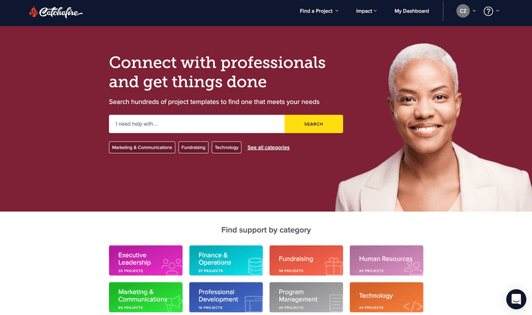The complete guide to nonprofit marketing

Marketing your organization to your community is a necessary part of having a successful nonprofit organization. After all, good marketing brings in new partners, donors, and long-term community engagement for your organization. This nonprofit marketing guide gives you simple tips to demonstrate your organization’s value.
Maintaining the attention of your community is vital, but marketing your nonprofit does not have to be a massive undertaking or as expensive as it may appear.
Simply put, you want to ensure your community knows:
- Who you are
- What you do
- How they can support you
Figuring out the best nonprofit marketing strategy for your organization depends heavily upon your mission, outreach goals, and community. Let’s break this down into two categories: online and offline marketing.
What is online marketing?

Online marketing involves promoting your nonprofit service offerings on the internet via your website, online ads, or social media.
Benefits of online marketing include:
- You can see, in real time, how your community is engaging with your content and promotions. With social media channels, you can easily see what your audience thinks of your organization and marketing. If you’re seeing lots of likes and shares of your content, then surely, you’re doing something right!
- It’s simple to track your return on investment (ROI). You can track clicks and impact when using ads online, so you can easily see which ads are the most profitable for you. Social media platforms, for example, make this data easily available to you because they want you to use their platform to grow. Tracking your ROI will help you to make smart decisions regarding future marketing strategies and campaigns.
- You can target specific demographics. With online marketing, it’s possible to drive specific types of people to your offers - people who are more likely to support your mission and buy your products.
There are also some negatives to using online marketing, such as:
- Digital advertisements can be annoying. While it’s certainly clever that advertisers can target ads specifically to you and show you ads for products that you searched for previously, they can be highly annoying and even drive you away from an organization.
- Online ads are fleeting. Unlike a billboard, an online ad can easily be missed or ignored. It’s easy to scroll past an ad and click to the next page without even taking notice.
- Online marketing is constantly evolving. Whether it’s the latest social media platform or a change to the search engine algorithm, there’s always something new to learn. If you don’t keep up with important trends, you may find yourself being left behind.
What is offline marketing?

Offline marketing is typically anything that does not involve the internet; magazine or television advertisements are good examples of this type of marketing.
Benefits of offline marketing include:
- Impactful and easy to understand. A billboard or TV commercial can often become part of a person's daily life, so it can be easy to digest and understand.
- Printed marketing materials are often permanent. Unless a magazine is recycled or put in the trash, then the advertisements found within will be permanent, so they can still work weeks or even months after first being published.
- They are memorable. Many offline ads are memorable and likely to be remembered much better than an Instagram ad for example, which is almost instantly forgotten. Think of all the popular Super Bowl ads and other commercials that we all know so well that become part of our culture.
Offline marketing also has some negative aspects, such as:
- It’s difficult to measure the success of a campaign. There are ways to measure the success of a campaign, but they are not as in-depth or accurate as those available for online marketing.
- It can be expensive. Typically, offline marketing can be expensive. Even a small run in your local newspaper or a single 30-second spot on TV can set you back a considerable amount.
- Little feedback from your audience. After running the marketing campaign, you can rarely gauge the reactions from your target audience.
Which is better for you?
Both online and offline marketing have their pros and cons.
Offline marketing is seen as more traditional and will be better aimed at an older generation, while online marketing is generally a better option for a younger demographic. However, these are only generalities and might not apply to your nonprofit organization.
Plus, you don’t have to choose one over the other. It’s possible that a combination of online and offline marketing will work best for your nonprofit.
Marketing tips for your nonprofit:

- Partner up with another mission-aligned organization or an influencer. Consider joining forces with an organization or influencer that shares your mission and values. Building a partnership allows you to offer a more substantial product together than either one of you could offer alone.
- In addition, you’ll automatically get the attention of both audiences, resulting in more impact and adding more leads to your email list. In the future, these new leads can drive more impact of another one of your services.
- Partnering on even one marketing campaign can bring long-term benefits to both of you. If the relationship is fruitful, consider launching this campaign yearly.
2. Be active on social media. There are millions of users visiting the various social media platforms daily, so it makes sense for your nonprofit to have a presence there.
- Share funny or interesting images or videos that are relevant to your mission and programming. This helps start a conversation and build connection with your audience.
- Post insights and valuable information.
- Communicate to your audience when you are starting a new program or have a special event.
- Encourage engagement by participating in discussions. Ask questions and answer theirs. Run a survey, poll, or contest.
- Validate your audiences’ experiences and show your appreciation for them. Highlight their testimonials about your organization. Every interaction adds value.
3. Change and reuse old advertisements. Rather than going through the expensive route of creating new assets with every marketing campaign, try reusing parts of an advertisement that previously worked well. This will save you time and money. Keeping brand consistency with your ads will help others recognize your organization.
4. Build an email list. If people are visiting your website, chances are good that they are interested in what you have to offer. Make a form available for them to join your email list and be kept in the loop about upcoming events and programming.
- Once they’ve signed up to this email list, you can send emails to these prospects with news and more information about your organization. Let them know if you have an upcoming event or fundraiser.
5. Create some video content. Video content is incredibly important nowadays - many would rather watch a video than read a blog post. If you can create interesting videos, you’ll create interest in your organization.
6. Look at the user experience. If you find that visitors are struggling to navigate your website or that you have a high bounce rate, which is when people leave your website after just a short time, take a close look at your user experience.
Perhaps your visitors aren’t finding the answers that they’re looking for, or maybe your website is broken in some way. Prioritize improving the overall experience of your visitors.
7. Create amazing content. Write high-quality content that answers questions that your readers might have about your mission.
- If you can answer a question in less than 1,000 words, that content is a great coffee break read. However, it’s also worth noting that it’s important to be thorough when necessary, so you may also want to consider incorporating longer form writing, averaging about 2,500-3,500 words. Many of the highest-ranking pages include longer, authoritative content.
- Tap into partnerships to create or share relevant content.
8. Optimize any images. You can do this by giving the filenames descriptive names. Using image alt text is also recommended so that the search engines can understand what images are present on your website. Properly optimized images can boost your website rank.
You will need to understand what you want to achieve marketing-wise, what your budget is, and most importantly who your target audience is. Study your audience and go with what you think will work best with them, also keeping your budget in mind. This will get you started.
How to create a nonprofit marketing plan

When starting your nonprofit marketing plan, you should always consider your previous marketing efforts. Review what has been successful in the past and plan for where you would like to grow in the future.
1. Define your nonprofit's marketing goals
Defining the mission and vision of your nonprofit organization seems pretty easy, but being able to convey your message to a wide audience can be tricky. Your overall marketing plan goal should be ‘to promote the organization's ideals and causes to get the attention of potential volunteers and donors.’
Here are some examples of goals you should consider:
- Increase awareness
- Create partnerships
- Discover new donors and/or fundraising opportunities
- Recruit volunteers
- Boost your social media presence
2. Understand your audience
Now that you have defined your goals you need to know how to best reach and make connections with your audience. As I mentioned above, determining whether your audience is online or offline is key. Audiences on social media platforms vary based on age. According to research, older adults (55+) use Facebook as their primary source of social media. They are also the same audience that is most likely to donate to worthy causes. On Facebook, you should gear your advertising towards fundraising events and share facts about your cause to inform your target audience.
Videos are powerful storytelling tools and are winning the marketing race right now for younger audiences. Consider transitioning some of your written content to short form video content. If you are a member of the Catchafire family, you can have one of our volunteer professionals edit and finalize a video for you.
3. Craft your key messages
Learning to incorporate storytelling in your nonprofit marketing plan is a skill that will benefit all of your initiatives. Communicating your message to an audience entails making a series of very intentional decisions. Being concise with word choice and understanding the tone your audience will perceive are things to focus on. Each word in your message should be working towards capturing the attention of your audience and making it easy for them to connect with your story.
Choose words that are simple, yet specific to your cause area, and are consistent with the urgency of your mission. Communicate in a way that people across demographics will understand. Keep your audience’s attention by remaining relevant to what they care about and how they talk about it. You want to leave an impression.
4. Sign up for Catchafire

Marketing and Communications is Catchafire’s most popular project category because it's the area that all nonprofits need, but it's also a funding category that has been historically undervalued. Using Catchafire for your nonprofit marketing plan is quite literally a game changer. Our volunteers have done marketing for some of the most recognizable brands in the world, and now they want to work with you.
If you’re looking for feedback or need a thought partner while creating your nonprofit marketing plan, you can make connections with professionals for 1-hour consultations on brand messaging or public relations, for example. Through our menu of over 150 scoped out projects, Catchafire volunteers can create social media content calendars, set up your email marketing campaigns, design your nonprofit’s Instagram strategy, or help you understand how your website is performing in the world of search engine optimization. Find help with storytelling, Facebook Ads, infographics, audio and video editing, graphic design - the list goes on and on! And remember: as a member you can post unlimited projects.
5. Analyze your marketing performance
Your nonprofit marketing goals will guide how you analyze the performance of your new marketing plan. If you made clear goals around donations and recruiting volunteers, for example, here are some key performance indicators (KPIs) to look for:
- Donations: month to month, and overall
- Donations by marketing channel (i.e. email campaigns, social media ads, website buttons)
- Conversions - single time donors converting to recurring status
- Volunteer inquiries: month to month, and overall
Keep in mind that more social media followers and website traffic is great. However, these aren’t direct indicators for meeting your goals. The sustainability of your marketing KPIs drive the sustainability of your nonprofit.
Examples of nonprofit marketing
Catchafire can make all of your marketing dreams come true by working with our volunteer professionals. We have thousands of volunteers ready, willing, and able to help you meet your goals and amplify your initiatives. Check out some connections made on Catchafire that helped two nonprofit organizations save time and thousands of dollars.

Video Editing in the Nick of Time
Hartford Performs, a nonprofit in Connecticut who uses the arts to enhance student learning, was in the middle of submitting an application for funding when the grant review panel requested to see them in action! They already had 20 minutes of video footage and useful images, but no one on their team possessed the skills to create a high-quality short video. They posted a video editing project on Catchafire, and connected with a volunteer named Samori, who was not only a video editor but a theater artist as well. Here’s what Hartford Performs’ executive director, Rie P., had to say about the experience:
“It was such a treat to work with Samori. Communication with him was excellent. He completed our video-editing project far faster than I anticipated. Plus, he added subtitles to the entire video. That's something I hadn't thought of doing, and it really enhanced the final project. We are very grateful for his help!”
The team at Hartford Performs now has more collateral to help tell their story and become better fundraisers.

Finding Safety with SEO
Simply put, search engine optimization helps people find you online. Vista Maria, an organization that offers mental health services, foster care and adoption, and secure independent living quarters for survivors of human trafficking, came to Catchafire with a great need. Recruiting foster families and connecting with social workers is at the heart of their work.
Their Senior Manager of Community Engagement, Jessica M., posted a project to assess how their website’s Search Engine Optimization was performing. Read her testimonial about working with Emiko M. below:
“Emiko provided a detailed report that was way beyond our expectations. She provided a fantastic assessment of our current web presence, as well as specific instructions for how to improve our SEO and reach new clients and referral sources. I know she saved us considerable time, energy, and funds that we can now put toward serving our youth. We're working with another volunteer to implement the changes Emiko suggested, and the report she compiled is an incredibly valuable tool in that process.”
You can find more impact stories like these by visiting catchafire.org/impact. Nonprofits on Catchafire can post a project or a call that will help them immediately boost their marketing efforts and reach their goals. We want nonprofits to have the things they need to secure funding, amplify their mission, and return to serving their communities.
Nonprofits deserve high-quality support that makes their organization stronger from the inside out, and that’s why Catchafire exists.
Get involved with Catchafire
Not sure wh ere to begin? Book a 30 minute call with a Nonprofit Advisor or sign up for an upcoming free webinar.
Want to get involved with supporting a nonprofit? Sign up today to volunteer and use your skills to support nonprofits and their missions.
If you’re a grantmaker and would like to learn more about equipping nonprofits in your community with responsive, high-quality operational support, let’s connect. Email us here.



